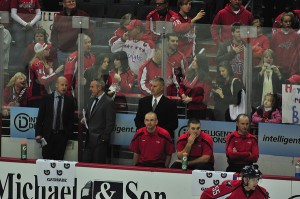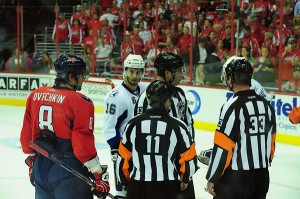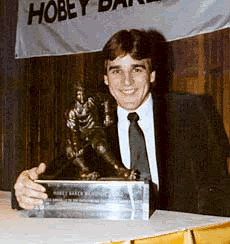After the Caps sent players back in Hershey and putting Nicklas Backstrom on LTIR to free cap space in case a deal was done, it seems the market price for everything was too high as Washington chooses choice “C”: stand pat. There was much talk about what the Capitals needed to get at the trade deadline, which players on the roster might move, and general manager George McPhee has said the Caps would go for a rental player and instead would aim to get a player for the future; however, those players didn’t seem available either.

For starters, the most likely reasoning for McPhee standing pat at the deadline is that when you look at the standings, teams are rather compressed in terms of points. “Everybody wanted to add, but nobody was selling,” said McPhee about the difficulty in getting a deal done. For a bit of perspective on the general manager’s side of things, in the East, the Caps’ own division, the Southeast, is so tight that four teams are technically in the running for the playoffs, despite the Lightning’s selling attitude at the deadline. The Bolts are still only five points behind the third-place Capitals. The Caps are one point out of the final playoff spot as of Monday afternoon, while the Jets are in eighth place two points behind the division-leading Panthers. Just from that alone, the weakest of all Eastern conference divisions has four teams well into the race, a lot of teams would be reluctant to throw the towel in — that’s just how hockey is.
Also, you can’t forget, the NHL is a business, too: just for making the playoffs, there is an automatic revenue boost from the NHL that every team that makes the playoffs get of at least $2 million. Considering the business aspect and pride, it makes it a pretty worthwhile endeavor to make the playoffs. So no one’s going to want to bow out of the race unless they really have to or can afford to do so — thus, affecting the market for players.
I also wouldn’t leave out the collective bargaining factor either, since they will be meeting end of the year to discuss new agreements, which could affect contracts from here on out, and with a lot of the players rumored to be on the move with such big numbers and long years, the commitment might be too much to fathom for a GM.

Consider that while some GM’s like Jay Feaster made bigger moves in early February or December, George McPhee has always been one to make the big deal AT the deadline, despite the team’s situation. “We’ve talked to every club at least ten times in last three, four days,” said McPhee. This year, it was more evident sooner than ever the team’s flaws at pivot. The center situation was further exposed when Backstrom went down with a concussion after receiving an elbow to the head from Montreal’s Rene Bourque. Since then, the Caps have filled the center void with players that barely equal permanent top-six center talent in the NHL. They’ve won two important games in a row this way, but with the race so tight as mentioned before, it might could have been further addressed with a more solid fix. Many expect Backstrom to be ready by the playoffs if the Capitals make it, and with his re-addition to the team the Caps may be able to pull off a convincing case for a run, but no one is even sure he can return by then.
Instead, especially so close to the end of the second-to-last month of the season, McPhee found trouble making additions to his team after teams analyze where they are in the standings and the players they’ll want.
“Everyone wants action, everybody wants to be making deals but you get in there and you see nothing but feathers,” said McPhee.
What would have worked in Washington’s favor was if the Capitals had made a move sooner than the deadline to avoid those driven-up prices. As Brian Burke mentioned in his post-deadline press conference, he acknowledged that he usually makes his moves in advance to relieve his players of pressure nearing the deadline, as he sees a hole in the team that needs to be addressed. He made sure to note that the pressures a Canadian team faces makes it the “hardest market to play in.” With Elliotte Friedman saying the Caps’ pressure to succeed is at a “Canadian-franchise level,” the Caps could have done themselves a favor with an early jump for various reasons.
At the beginning of the month, I had suggested a few players the Caps can go after. With regards to my suggestions, Jeff Carter was a risky and questionable pick due to rumored attitude issues and a lengthy contract. However, as a shoot-first player on a team that needs better offensive decisions on a consistent basis and a two-way center on a team that is as thin as it is at the position, he would have certainly made sense for the Caps. Unfortunately for them, he was reunited with his former teammate, Mike Richards in Los Angeles. Some players, like Derek Roy, Mike Ribeiro and Steve Ott, were on teams that fell into the “buyer” category — teams that felt like they could afford to keep their players for future purposes or a playoff push. Others, like Sam Gagner, who would have been nice for the Caps’ “long-term solution” concept, heated up as soon as his name entered trade talks.

The other side of the deadline issue considers players that are on the Caps’ roster already. Players like Roman Hamrlik and Mike Knuble were heavily rumored to be shopped around the league and/or unhappy with their current situations in Washington (what well-seasoned veteran player wants to be a healthy scratch, after all?). During TSN’s trade deadline broadcast, Marc Crawford brought up the point of the guys who are not dealt, how do they feel and perform afterward. While he named players who were not particularly disappointed with their current situations, for the Capitals, for a player like Knuble who would probably earn more playing time elsewhere, it would be tough to have him continue on. It helps for the Caps, Knuble is a trooper, and will stick out the season with his head up, but it would still be hard to also assume the possibility would not affect him. As far as Hamrlik goes, that might be a more difficult situation. McPhee said, “The guys that have sat out last week aren’t necessarily the guys that will sit out next week,” but that’s all up to coach Dale Hunter going down the home stretch of the season.
McPhee, while he expects to be able to further repair the team in the summer, it is fair to question whether this helps or hurts his job security. Aside from being unable to create deals that swung his way even under the urgent circumstances (much like he did with Greg Sherman, trading Semyon Varlamov for a 2012 first rounder and a conditional second round pick), he has had other questionable moments in his career as the Capitals’ GM. For one, prior to Alex Ovechkin’s arrival in Washington, he had trouble drafting useful, NHL-caliber players. He saw the failures to re-sign players that could have been more permanent solutions to the problems audiences are still seeing today, such as Eric Belanger and Scott Hannan. There was also McPhee’s decision to stand pat the off-season after losing to the Montreal Canadiens in the first round of the playoffs. It is possible one could tack on hiring a junior coach to run an experienced NHL team, too.
The theme of this 2012 deadline can be summed up by McPhee’s comment, saying, “There are more mistakes at the trade deadline… we weren’t going to make a mistake — we weren’t going to chase a bad deal.” The deadline is about risks and as they sit in ninth in the East with 20 games left, the Caps are taking a huge one trying to make the playoffs with the roster they have now.